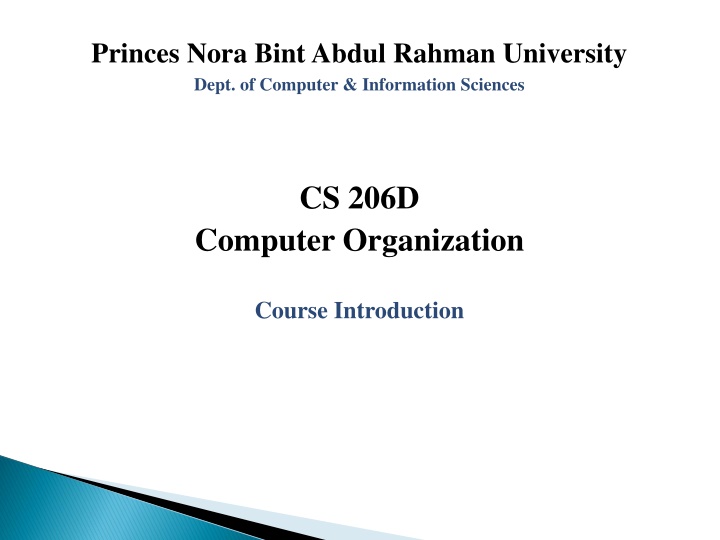
Based on the provided content, here are the requested items: "Computer Organization and Assembly Language Course Overview
"Explore Princes Nora Bint Abdul Rahman University's Computer Organization course covering topics like computer architecture, assembly language programming, and assessment methods. Dive into the fundamentals of microcomputer systems, IBM PC assembly language, and more."
Download Presentation

Please find below an Image/Link to download the presentation.
The content on the website is provided AS IS for your information and personal use only. It may not be sold, licensed, or shared on other websites without obtaining consent from the author. If you encounter any issues during the download, it is possible that the publisher has removed the file from their server.
You are allowed to download the files provided on this website for personal or commercial use, subject to the condition that they are used lawfully. All files are the property of their respective owners.
The content on the website is provided AS IS for your information and personal use only. It may not be sold, licensed, or shared on other websites without obtaining consent from the author.
E N D
Presentation Transcript
Princes Nora Bint Abdul Rahman University Dept. of Computer & Information Sciences CS 206D Computer Organization Course Introduction
Lecturer: Yasmeen Albarrak Office: 2.505.21 e-mail: ysalbarrak@pnu.edu.sa Credit Hours: 3 Course web site: https://pnucs206.wordpress.com/lectures-slides/
Computer Architecture: A Quantitative Approach, 4th Edition John Hennessy, David Patterson. Assembly Language for x86 Processors , 6th edition, by Kip R. Irvine, Prentice Hall, 2012 Assembly Language Programming and Organization of the IBM PC, Ytha Yu and Charles Marut
Assessment method Assessment method Assessment Week Assessment Week Percentage from overall grade Percentage from overall grade Grade Grade Quiz MID1 MID2 6 7 5 5% 10% 15% 5% 10% 15% 10 15 12 Lab attendance &participation + assessments After the end of each chapter 15 15% 15% Final Lab Final 15 40 15% 40% 15% 40%
Part I : Computer organization Part II: Assembly Language Application (Netscape) Operating System (Unix; Windows 9x) Compiler Assembler Software Instruction Set Architecture Hardware Processor Memory I/O system Datapath & Control Digital Design Circuit Design transistors, IC layout CS 206 D
Explains how computers are designed and how does it work. The components of a microcomputer system (Memory types, CPU, Buses, I/O Ports). Instruction Execution Cycle. Microcomputer architecture. Processor architecture instruction types, register sets, addressing modes and basic Instructions.
Introduction to the IBM PC assembly language (syntax, Variables..etc) The Processor Status and the FLAGS Registers. Flow Control Instructions. Logic Shift and Rotate Instructions. Multiplication and Division instructions. Array and addressing Modes.
Machine Language Language Assembly Language High-Level Collection of binary numbers encoded Data and instructions Symbolic form of machine Combines algebraic language (i.e. symbolic names are used to represent from English language operations, registers & memory locations) expressions & symbols taken (ex. Pascal, COBOL FORTRAN, etc) Ex. 10100001 00000000 00000000 MOV AX,A 00000101 00000100 00000000 ADD AX,4 10100011 00000000 00000000 MOV A,AX Ex. Ex. A = A + 4
Machine Language Assembly Language High-Level Language Directly understood by a computer Assembler converts to machine language Compiler (or interpreter) converts to machine language 1 assembly language instruction = 1 machine language instruction 1 HLL instruction = many machine language instructions Not standard (i.e. different machine language for every ISA for Computer family) Not standard (i.e. different Standard (i.e. programs are assembly language for every type of machine) executed) independent of the machine on which they will be
Advantages of Assembly Language Performance: A well-written Assembly language program produces a faster, shorter machine language program. For Some applications speed and size is critical Access to hardware: Some operations, such as reading or writing to specific memory locations & I/O ports can be done easily in Assembly but may be impossible by a higher level language. Studying ASM language gain a feeling of the way the computer thinks and the ways that things are happen inside the computer.



